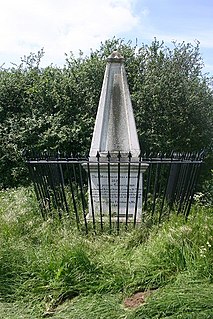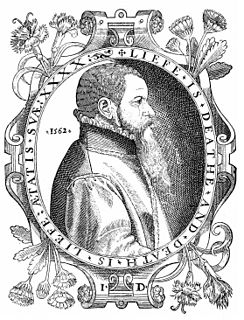Related Research Articles

Myles Coverdale, first name also spelt Miles, was an English ecclesiastical reformer chiefly known as a Bible translator, preacher and, briefly, Bishop of Exeter (1551–1553). Regarding his probable birth county, Daniell cites John Bale, author of a sixteenth century scriptorium, giving it as Yorkshire. Having studied philosophy and theology in Cambridge, Coverdale became an Augustinian friar and went to the house of his order, also in Cambridge. In 1514 John Underwood, a suffragan bishop and archdeacon of Norfolk, ordained him priest in Norwich. He was at the house of the Augustinians when in about 1520, Robert Barnes returned from Louvain to become its prior. In 1535, Coverdale produced the first complete printed translation of the Bible into English. His theological development is a paradigm of the progress of the English Reformation from 1530 to 1552. By the time of his death, he had transitioned into an early Puritan, affiliated to Calvin, yet still advocating the teachings of Augustine.

John Foxe, an English historian and martyrologist, was the author of Actes and Monuments, telling of Christian martyrs throughout Western history, but particularly the sufferings of English Protestants and proto-Protestants from the 14th century and in the reign of Mary I. Widely owned and read by English Puritans, the book helped to mould British opinion about the Catholic Church for several centuries.

Rowland Taylor was an English Protestant martyr during the Marian Persecutions.

John Day was an English Protestant printer. He specialised in printing and distributing Protestant literature and pamphlets, and produced many small-format religious books, such as ABCs, sermons, and translations of psalms. He found fame, however, as the publisher of John Foxe's Actes and Monuments, also known as the Book of Martyrs, the largest and most technologically accomplished book printed in sixteenth-century England.

Anne Askew was an English writer, poet, and Protestant martyr who was condemned as a heretic in England in the reign of Henry VIII of England. Along with Margaret Cheyne, wife of Sir John Bulmer, who was similarly tortured and executed after the Pilgrimage of Grace in 1537, she is the only woman on record known to have been both tortured in the Tower of London and burnt at the stake. She is also one of the earliest known female poets to compose in the English language and the first Englishwoman to demand a divorce.
John Marbeck, Merbeck or Merbecke was an English theological writer and musician who produced a standard setting of the Anglican liturgy. He is also known today for his setting of the Mass, Missa Per arma justitiae.
Events from the 1540s in England.
John Capon, aliasJohn Salcot was a Benedictine monk who became bishop of Bangor, then bishop of Salisbury under Henry VIII. He is often referred to as John Salcot alias Capon.
Robert Testwood of London was an English Protestant martyr during the reign of Henry VIII, one of the Windsor Martyrs.

The Colchester Martyrs were 16th-century English Protestant martyrs. They were executed for heresy in Colchester, Essex, during the reigns of Henry VIII and Mary I. Their story is recorded in Foxe's Book of Martyrs.
The Canterbury Martyrs were 16th-century English Protestant martyrs. They were executed for heresy in Canterbury, Kent, and were the last protestants burnt during the reign of Mary I. Their story is recorded in Foxe's Book of Martyrs.
Anthony Pearson was a 16th-century English Protestant who was executed for heresy during the reign of King Henry VIII of England. He is known as one of the Windsor Martyrs.
Henry Filmer was a 16th-century English Protestant martyr, one of the Windsor Martyrs, during the reign of Henry VIII.
Robert Benet was the Mayor of Windsor, England in 1536.
The Perth Martyrs were six people executed in Perth, Scotland in 1543 for their Protestant beliefs. The condemned people were William Anderson, James Finlayson, James Hunter, Robert Lamb, James Raveleson and Helen Stark. They were sentenced to death for their beliefs, after being convicted by the Archbishop of St Andrews. Anderson, Finlayson, Hunter and Lamb were sentenced to be hanged, Raveleson was to be burnt; and Helen Stark, "with her sucking infant", was to be put into a sack and drowned. Their story is recorded in Foxe's Book of Martyrs, in Calderwood's History of the Kirk of Scotland and in James Anthony Froude's History of England.

The Actes and Monuments, popularly known as Foxe's Book of Martyrs, is a work of Protestant history and martyrology by Protestant English historian John Foxe, first published in 1563 by John Day. It includes a polemical account of the sufferings of Protestants under the Catholic Church, with particular emphasis on England and Scotland. The book was highly influential in those countries and helped shape lasting popular notions of Catholicism there. The book went through four editions in Foxe's lifetime and a number of later editions and abridgements, including some that specifically reduced the text to a Book of Martyrs.
John London, DCL was Warden of New College, Oxford, and a prominent figure in the Dissolution of the Monasteries during the reign of Henry VIII of England.
Richard Arche LL.B., D.C.L. was a Canon of Windsor from 1538 to 1553
References
- 1 2 3 4 5 Ford, David Nash (2009). Berkshire in the Reign of Henry VIII. Wokingham: Nash Ford Publishing.
- ↑ p.171-176, Testwood and his Companions, John Foxe, Foxe's Book of Martyrs , 2000, Ambassador Publications